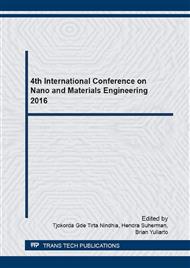[1]
W. -Y. Huang, Y. -Z. Cai, Y. Zhang, Natural phenolic compounds from medicinal herbs and dietary plants: potential use for cancer prevention, Nutrition and cancer, 62 (2009) 1-20.
DOI: 10.1080/01635580903191585
Google Scholar
[2]
R. Mammucari, F. Dehghani, N. Foster, Dense Gas Processing of Micron-Sized Drug Formulations Incorporating Hydroxypropylated and Methylated Beta-Cyclodextrin, Pharm Res, 23 (2006) 429-437.
DOI: 10.1007/s11095-005-9094-7
Google Scholar
[3]
J. Jung, M. Perrut, Particle design using supercritical fluids: literature and patent survey, The Journal of Supercritical Fluids, 20 (2001) 179-219.
DOI: 10.1016/s0896-8446(01)00064-x
Google Scholar
[4]
E.J. Beckman, Supercritical and near-critical CO2 in green chemical synthesis and processing, The Journal of Supercritical Fluids, 28 (2004) 121-191.
DOI: 10.1016/s0896-8446(03)00029-9
Google Scholar
[5]
T. Noiklam, A. Sane, Formation of curcumin nanoparticles using rapid expansion subcritical solutions into liquid solvents (RESOLV), Nano-Thailand, NanoThailand, (2012).
Google Scholar
[6]
M. Kakran, N.G. Sahoo, I. -L. Tan, L. Li, Preparation of nanoparticles of poorly water-soluble antioxidant curcumin by antisolvent precipitation methods, Journal of Nanoparticle Research, 14 (2012) 1-11.
DOI: 10.1007/s11051-012-0757-0
Google Scholar
[7]
P.J. Ginty, M.J. Whitaker, K.M. Shakesheff, S.M. Howdle, Drug delivery goes supercritical, Materials Today, 8 (2005) 42-48.
DOI: 10.1016/s1369-7021(05)71036-1
Google Scholar
[8]
Ž. Knez, T. Perko, M. Škerget, Antioxidant and antimicrobial activity of PGSS micronized curcuma powder ISSF, ISSF San Fransisco, (2012).
Google Scholar
[9]
F. Zabihi, N. Xin, J. Jia, T. Chen, Y. Zhao, High Yield and High Loading Preparation of Curcumin–PLGA Nanoparticles Using a Modified Supercritical Antisolvent Technique, Industrial & Engineering Chemistry Research, 53 (2014) 6569-6574.
DOI: 10.1021/ie404215h
Google Scholar
[10]
F. Kurniawansyah, H.T.T. Duong, T.D. Luu, R. Mammucari, O. Vittorio, C. Boyer, N. Foster, Inhalable curcumin formulations: Micronization and bioassay, Chemical Engineering Journal, 279 (2015) 799-808.
DOI: 10.1016/j.cej.2015.05.087
Google Scholar


